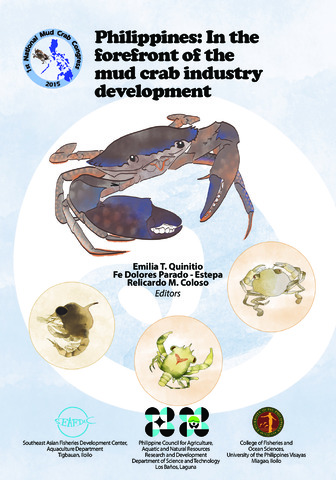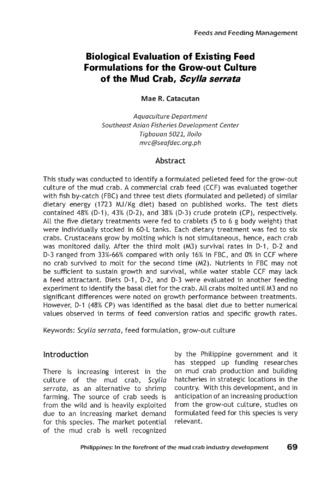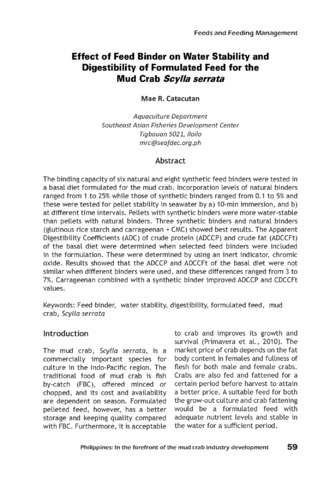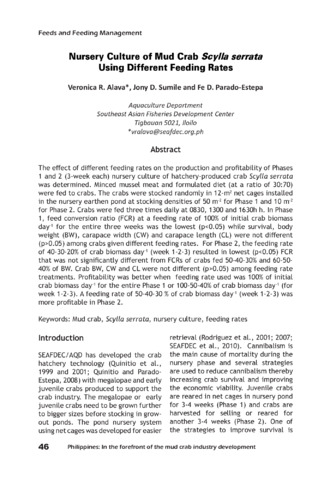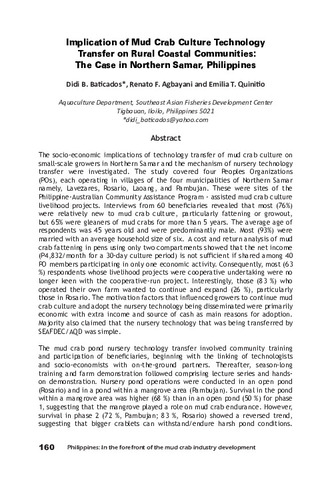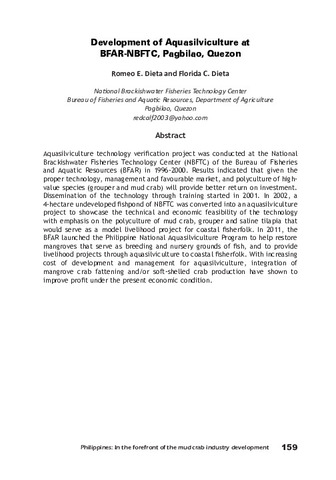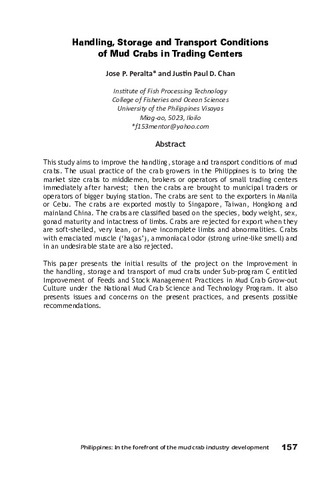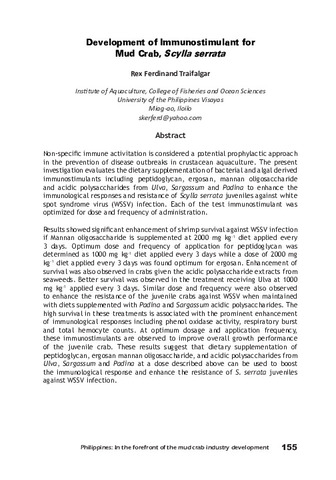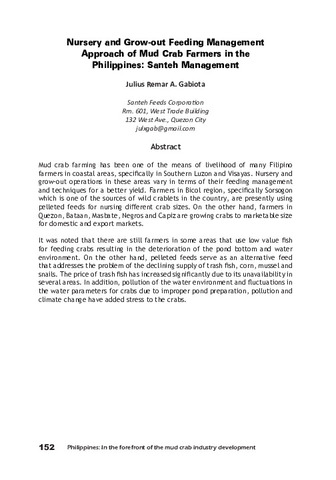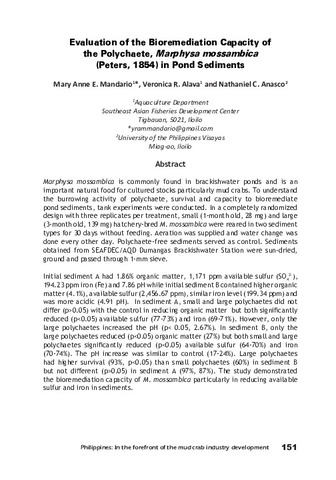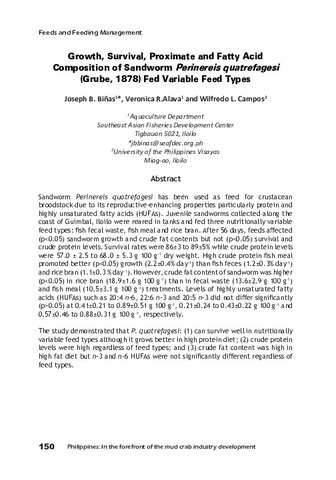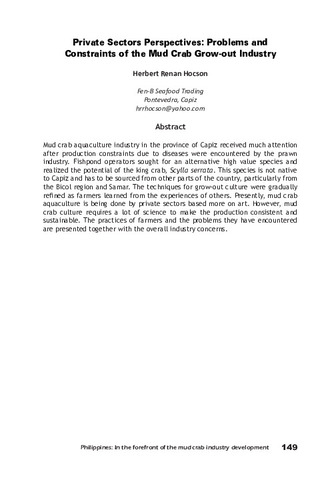Philippines : In the forefront of the mud crab industry development
Browse by
Contents
- FOREWORD
- ACKNOWLEDGEMENTS
- PHOTO OF THE PARTICIPANTS
-
A. Technical Papers
-
Husbandry
- Recent Developments and Enhancing Transfer of the Nursery Technology for the Mud Crab Scylla serrata - Fe D. Parado-Estepa, Veronica Alava, Esteban Garibay, Churchill Bejemino, Jony Sumile, Jenalyn Silvestre and Emilia T. Quinitio
- Management Strategies for Grow-out Culture of Mud crab - Jerome G. Genodepa
- Development of Protocol for the Production of Hatchery-reared Mud Crab Scylla serrata Juveniles for Soft-shell Crab Farming - Emilia T. Quinitio, Gardel Xyza Libunao and Fe D. Parado-Estepa
-
Feeds and Feeding Management
- Breeding and Culture of the Polychaete Marphysa mossambica as Feed for the Mud Crab Scylla serrata Broodstock - Veronica R. Alava, Joseph B. Biñas and Mary Anne E. Mandario
- Nursery Culture of Mud Crab Scylla serrata Using Different Feeding Rates - Veronica R. Alava, Jony D. Sumile and Fe D. Parado-Estepa
- Nursery Culture of Mud crab Scylla serrata Using Different Ratios of Natural Food to Formulated Feed - Veronica R. Alava, Jony D. Sumile and Fe D. Parado-Estepa
- Effect of Feed Binder on Water Stability and Digestibility of Formulated Feed for the Mud Crab Scylla serrata - Mae R. Catacutan
- Biological Evaluation of Existing Feed Formulations for the Grow-out Culture of the Mud Crab, Scylla serrata - Mae R. Catacutan
- Diseases
- Aquasilviculture
-
Husbandry
-
B. Papers on Industry Practices
- Trading of Juvenile Crabs and Grow-out Culture in Capiz - Graciano Jalemar Panaguiton
- Polyculture of Mud Crab in Region 3 - Maurino Bonifacio
- Mud Crab Fattening Project of KAMAMANA in Del Carmen, Siargao Island - Agapito E. Sulima
- Capacity Building Initiatives of Winrock International on Mud Crab Culture in the Caraga Region - Joselito Nobillos, Daniel Gudahl and Jim Orprecio
- Mud Crab Marketing Practices - Alain G. Decembrana
- Enforcement of the Unified Provincial Fisheries Law in Camarines Norte with Focus on Mud Crab - Edgar A. Estanislao
- Philippine National Standard for Live Mud Crabs: Establishing Food Safety and Quality Requirements - Mark F. Matubang, Teresita S. Palomares, Jose P. Peralta, Emilia T. Quinitio, Rosario J. Ragaza, Julieta V. Alejo, Prescilla B. Regazpi, Cherry E. Romero, Haydee Ann Montoya, Jaypee G. Trinidad and Karen Kristine A. Roscom
-
C. Abstracts of Other Presented Papers (Oral and Poster)
-
Biology, Genetics and Ecology
- Identification of Mud Crab Species in Coastal Areas of Pangasinan - Rolando B. Cerezo and Mariel C. Tapia
- Genetic Diversity and Stock Delineation of Philippine Populations of the Orange Mud Crab, Scylla olivacea - Faith Jessica M. Paran and Rachel June Ravago-Gotanco
- Population Structure of Scylla serrata from Microsatellite and mtDNA Markers - Chona Camille E. Vince Cruz and Ma. Carmen Ablan-Lagman
- High Throughput RNA Sequencing Reveals Temperature Tolerance Mechanisms in Scylla serrata - Ma. Carmen Ablan-Lagman and Eli Meyer
-
Husbandry
- Updates on the Larviculture of Mud Crab at SEAFDEC/AQD - Emilia T. Quinitio, Joana Joy Huervana, Juliette C. Virgula and Fe D. Parado-Estepa
- Mud Crab Scylla serrata Hatchery Operation - Mario Santos and Francisco Santos
- Mud Crab Production Trials at the College of Fisheries and Marine Sciences, Aklan State University, New Washington, Aklan - Yasmin H. Primavera-Tirol, Ronnie de la Cruz and Eduardo B. Pastrana
- Initiatives on Mud Crab Culture at the Palawan Aquaculture Corporation - Elsie Tech, Cheryl Emboltorio, Domingo Galila, Cornelio Ogsimer and Kimberly Lim
- Induction of Molting in Hatchery-reared Mud Crab Scylla serrata Juveniles Through Temperature Manipulation or Autotomy - Joana Joy D.C. Huervana, Valeriano L. Corre Jr. and Emilia T. Quinitio
- Morphological Deformities in Mud Crab Scylla serrata Juveniles Exposed to Antibiotics During the Larval Stage - Gaudioso S. Pates Jr., Emilia T. Quinitio, Gerald F. Quinitio and Fe D. Parado-Estepa
- Nursery Culture of Mud Crab Scylla serrata Fed Diets Supplemented with Tryptophan at Two Stocking Densities - Veronica R. Alava, Marjorie Aijee Lucero, Jony D. Sumile and Fe D. Parado-Estepa
- Adoption of Modified Commercial Scale Mud Crab Hatchery and Nursery Systems in Alaminos, Pangasinan - Rolando B. Cerezo and Jesamine F. Rebugio
- Private Sectors Perspectives: Problems and Constraints of Mud Crab Grow-out Industry - Herbert Renan Hocson
-
Feeds and Feeding Management
- Growth, Survival, Proximate and Fatty Acid Composition of Sandworm Perinereis quatrefagesi (Grube, 1878) Fed Variable Feed Types - Joseph B. Biñas, Veronica R.Alava and Wilfredo L. Campos
- Evaluation of the Bioremediation Capacity of the Polychaete, Marphysa mossambica (Peters, 1854) in Pond Sediments - Mary Anne E. Mandario, Veronica R. Alava and Nathaniel C. Anasco
- Nursery and Grow-out Feeding Management Approach of Mud Crab Farmers in the Philippines: Santeh Management - Julius Remar A. Gabiota
- Pilot Scale Production of Pellets Suitable for Mud Crab Scylla serrata - Relicardo M. Coloso, Mae R. Catacutan, Jose P. Peralta, Jerome G. Genodepa, Khrsha Duno and Rosthon Gardoce
- Diseases
- Post harvest
-
Aquasilviculture
- Enhancing Mud Crab Population through Mangrove Restoration - Ma. Junemie Hazel Lebata-Ramos, Ellen Flor Doyola-Solis, Rema C. Sibonga, Joseph B. Biñas, Mark Walton and Lewis Le Vay
- Development of Aquasilviculture at BFAR-NBFTC, Pagbilao, Quezon - Romeo E. Dieta and Florida C. Dieta
- Implications of Mud Crab Culture Technology Transfer on Rural Coastal Communities: The Case in Northern Samar, Philippines - Didi B. Baticados, Renato F. Agbayani and Emilia T. Quinitio
-
Biology, Genetics and Ecology
- D. Workshop Output
- E. Resolution
-
F. Annexes
- 1. List of Participants
- 2. Composition of Committees
Recent Submissions
-
Philippines: In the forefront of the mud crab industry: Proceedings of the 1st National Mud Crab Congress
(Aquaculture Department, Southeast Asian Fisheries Development Center, 2017) -
Biological evaluation of existing feed formulations for the grow-out culture of the mud crab, Scylla serrata
(Aquaculture Department, Southeast Asian Fisheries Development Center, 2017)This study was conducted to identify a formulated pelleted feed for the grow-out culture of the mud crab. A commercial crab feed (CCF) was evaluated together with fish by-catch (FBC) and three test diets (formulated and ... -
Effect of feed binder on water stability and digestibility of formulated feed for the mud crab Scylla serrata
(Aquaculture Department, Southeast Asian Fisheries Development Center, 2017)The binding capacity of six natural and eight synthetic feed binders were tested in a basal diet formulated for the mud crab. Incorporation levels of natural binders ranged from 1 to 25% while those of synthetic binders ... -
Nursery culture of mud crab Scylla serrata using different feeding rates
(Aquaculture Department, Southeast Asian Fisheries Development Center, 2017)The effect of different feeding rates on the production and profitability of Phases 1 and 2 (3-week each) nursery culture of hatchery-produced crab Scylla serrata was determined. Minced mussel meat and formulated diet (at ... -
Nursery culture of mud crab, Scylla serrata, using different ratios of natural food to formulated feed
(Aquaculture Department, Southeast Asian Fisheries Development Center, 2017)The effect of feeding different ratios of natural food to formulated feed on the production and profitability of Phases 1 and 2 of nursery culture (3 weeks per phase) of hatchery-produced crab Scylla serrata was investigated. ... -
Breeding and culture of the polychaete, Marphysa mossambica, as feed for the mud crab
(Aquaculture Department, Southeast Asian Fisheries Development Center, 2017)Marine worms (Annelida: Polychaeta) are considered as important food for crustacean broodstock because they contain hormones and correct balance of essential nutrients for reproduction. Marphysa mossambica (Peters, 1854) ... -
Implication of mud crab culture technology transfer on rural coastal communities: The case in northern Samar, Philippines
(Aquaculture Department, Southeast Asian Fisheries Development Center, 2017)The socio-economic implications of technology transfer of mud crab culture on small-scale growers in Northern Samar and the mechanism of nursery technology transfer were investigated. The study covered four Peoples ... -
Development of aquasilviculture at BFAR-NBFTC, Pagbilao, Quezon
(Aquaculture Department, Southeast Asian Fisheries Development Center, 2017)Aquasilviculture technology verification project was conducted at the National Brackishwater Fisheries Technology Center (NBFTC) of the Bureau of Fisheries and Aquatic Resources (BFAR) in 1996-2000. Results indicated that ... -
Enhancing mud crab population through mangrove restoration
(Aquaculture Department, Southeast Asian Fisheries Development Center, 2017)Mangroves are known as important nurseries for different species of fish and shellfish. In the Philippines, mud crabs Scylla spp. are among the most valuable crustaceans harvested from the mangroves and are considered a ... -
Handling, storage and transport conditions of mud crabs in trading centers
(Aquaculture Department, Southeast Asian Fisheries Development Center, 2017)This study aims to improve the handling, storage and transport conditions of mud crabs. The usual practice of the crab growers in the Philippines is to bring the market size crabs to middlemen, brokers or operators of small ... -
Development of protocol for the production of hatchery-reared mud crab Scylla serrata juveniles for soft-shell crab farming
(Aquaculture Department, Southeast Asian Fisheries Development Center, 2017)Development of economically viable techniques for growing hatchery-reared juvenile crabs to suitable sizes will address the problem on the source of seed stocks for soft-shell crab farming. This paper reports the production ... -
Defects in the handling, storage and transport of mud crab
(Aquaculture Department, Southeast Asian Fisheries Development Center, 2017)Consumers prefer to buy live mud crabs (Scylla). Moribund and dead crabs have very low market value. Immediately after harvest, the crabs are tied to render their claws immobile. The time between harvest and arrival of ... -
Development of immunostimulant for mud crab, Scylla serrata
(Aquaculture Department, Southeast Asian Fisheries Development Center, 2017)Non-specific immune activitation is considered a potential prophylactic approach in the prevention of disease outbreaks in crustacean aquaculture. The present investigation evaluates the dietary supplementation of bacterial ... -
Strategies to reduce disease incidence in mud crab culture
(Aquaculture Department, Southeast Asian Fisheries Development Center, 2017)Mud crab hatchery suffers from low survival due to susceptibility to bacterial infection in the early larval stages among many causes. Despite food safety issues, antibiotics continue to be used in the absence of effective ... -
Pilot scale production of pellets suitable for mud crab Scylla serrata
(Aquaculture Department, Southeast Asian Fisheries Development Center, 2017)Studies were conducted towards the pilot scale production of stable and nutritionally adequate pellets suitable for mud crab Scylla serrata to help in efforts to increase mud crab production in the Philippines. Preliminary ... -
Nursery and grow-out feeding management of mud crab farmers in the Philippines: Santeh experience
(Aquaculture Department, Southeast Asian Fisheries Development Center, 2017)Mud crab (Scylla serrata) farming has been one of the means of livelihood of many Filipino farmers in coastal areas, specifically in Southern Luzon and Visayas. Nursery and grow-out operations in these areas vary in terms ... -
Evaluation of the bioremediation capacity of the polychaete, Marphysa mossambica (Peters, 1854) in pond sediments
(Aquaculture Department, Southeast Asian Fisheries Development Center, 2017)Marphysa mossambica is commonly found in brackishwater ponds and is an important natural food for cultured stocks particularly mud crabs. To understand the burrowing activity of polychaete, survival and capacity to ... -
Growth, survival, proximate and fatty acid composition of sandworm Perinereis quatrefagesi (Grube, 1878) fed variable feed types
(Aquaculture Department, Southeast Asian Fisheries Development Center, 2017)Sandworm Perinereis quatrefagesi has been used as feed for crustacean broodstock due to its reproductive-enhancing properties particularly protein and highly unsaturated fatty acids (HUFAs). Juvenile sandworms collected ... -
Private sectors perspectives: Problems and constraints of the mud crab grow-out industry
(Aquaculture Department, Southeast Asian Fisheries Development Center, 2017)Mud crab aquaculture industry in the province of Capiz received much attention after production constraints due to diseases were encountered by the prawn industry. Fishpond operators sought for an alternative high value ... -
Adoption of modified commercial scale mud crab hatchery and nursery systems in Alaminos City, Pangasinan
(Aquaculture Department, Southeast Asian Fisheries Development Center, 2017)Pangasinan’s vast fishpond and mangrove areas have not been fully tapped for mud crab (Scylla serrata) production. The main reason identified for this is the limited supply of crab seedstock. At present, there is no reliable ...

